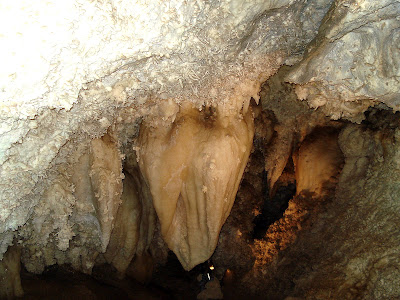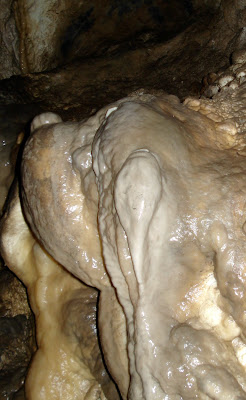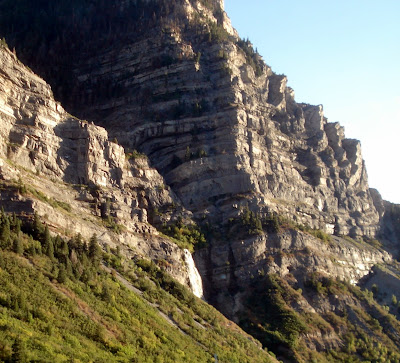I absolutely LOVE caves! There is just something about the drippy damp cool air, and the amazing shapes that are found deep beneath the ground that puts a huge sense of awe and joy in my heart.
My mom told me she had visited this cave as a young girl.
I wonder how much it has changed since then.
The cavern is in the Timpanogos Mountains. It actually is a series of three caverns. The first was discovered back in 1887 by a guy named Martin Hansen. He "claimed" it, and led visitors straight up the mountainside and into the cave as a business. Pictures of people clawing their way up the face of the mountain...whoa. I think they were crazy.
Across the way (pictured above) are the mountains facing the cavern. Professional climbers avoid climbing those faces. Too many slides...too dangerous.
The cave we were visiting was once equally difficult to access. Back in 1887 Hansen tracked a cougar up through the snow and discovered the cave. I'd say he was one crazy guy to go up such a mountain for one, and even more crazy to go inside a cave with just a small candle or lamp for light.Later two other caverns were discovered. People had taken "souvenirs" from the first cavern, and when the last cavern was discovered in 1922, (by the son and grandson of Hansen) they realized that the cavern's beauty needed to be protected and preserved for all to enjoy.
In 1922, at the urging of Utah citizens,the caverns were established as a National Monument. The National Park Service were charged with their over site and care, and (bless them) put in a reasonable way to get to the caves and made a path to walk through the caves that were joined via some stonework passages that they created with minimum damage to the cavern scenery.
We purchased tickets and began our walk up the mountain. It was 1.5 miles up, according to the posted sign. Over 382 meters.Darn near straight up....
We were give a tour time, told to go eat lunch or look around for an hour, and then start up, giving ourselves about an hour to climb.
We decided to just start climbing, knowing I would dilly-dally along the way.
The tap root spanning the rock belongs to the tiny tree atop.
Knowing that the root is growing straight down and the tree is growing straight up helps illustrate how much the mountain range has shifted since creation, and how the caves were formed.
Yup, that is where we started from, down below. I'm leaning back trying to catch my breath.
Remember the valley floor below is 4327 feet (1320 m) above sea level. The air is thin up here!
The tiny building above is where we are headed. This shot was taken 3/4 of the way up the mountain.
A set of grandparents and a little granddaughter kept pace with us. People heading down the mountain cheered us on...promising (falsely) that the end was just a little ways ahead, and (truthfully) that the cave was totally worth it.
Eventually...pant pant wheeze pant huff whoo...we made it to the cavern door! A small crowd had gathered...and our ticket time was still an hour away. Much to our surprise, we actually had made pretty good time getting up there, climbing the 382 meters in just an hours time.
Lucky for us, the crowd waiting around us for the upcoming tour was just part of a group, and the group's tickets were held by someone still down the mountain.
The ranger agreed to let the eight of us who were already present for the next hour's tour "jump line" and begin the tour ahead of time. Since the scheduled crowd outside included several howling babies, this was WONDERFUL news for us! We waved a cheery bye-bye as we left them to enter the cave.
(Why would anyone want to haul a baby or toddler up to see a cave? Strollers were not allowed on the trail! This experience would mean nothing to a baby, and the protesting howls would just make the rest of us miserable! Just sayin' is all...)
Just inside the door, eight of us got our first look at the treasures of the cave. A structure called flowstone, it was created by a flow of water across a wall of the cave.Even though I have been in several caverns in my life, I am still in awe of what water and mineral and time creates under ground.
The cavern had several "rooms." This room was once filled with water, now it has small puddles, but the stalactites still drip water.
Stalactites, like icicles hanging from the ceiling, form via the minerals left behind as water seeps down through the cave roof drip after drip after drip for centuries.
I can still hear a teacher's voice instructing: Stalactites hang TIGHT to the ceiling....
Some of the dripping points create stalactites, others create drapery like forms, also known as "cave bacon." They form when water trickles down an incline. They are rarely more than an inch thick and are often translucent. A friendly Park Ranger will often delight tours by playing a flashlight behind a drape, creating a beautiful glowing piece and ooohs and ahhhs from the tourists.
Our ranger shining a light up to the forms. Some where translucent, others quite solid. She nicely explained what each color represented in terms of mineral content...I was too busy admiring the forms to remember what she said.
Later (about two seconds ago...) I re-read in the brochure that the mineral is an orange-colored calcite.
I feel much better now...details like that are SO important to know!
The path through the caverns often got quite narrow. I commented to the ranger that hugely overweight people probably can't manage the hike, and so the narrow cave path isn't a problem, right? She laughed and said it hadn't been until a couple of weeks ago when a goaded guy took three hours to slowly walk up the path, and then promptly got stuck inside the cave passage. It took two hours to get him free...while his teenage daughters who had goaded him on had to deal with that embarrassing situation.
(I'm just glad I turned down dessert the night before. Just sayin' is all....)
Can't you see how at one time this was a lake? We have visited a cave in Tennessee, called Looking Glass Cavern, where the "lakes" still cover the floor of the cave. When light is shone in the cave, the reflection on the glass like lake reflects the cave ceiling perfectly. It was an awesome sight to see.
And Looking Glass Caver was so much more easy to reach.
A vistit to that cavern required just a walk across a small parking lot!
I was (again) too busy staring and gaping and photographing everything to remember what the ranger said about these structures. Good thing there wasn't going to be a test after this field trip.
The star/vein/root like forms are called Helictites. Timpanogos Cave's claim to fame is the tremendous number of helicitite forms, coupled with anthodites, which is very uncommon.
Helicitites twist and turn unpredictably in all dirctions, seemingly defying gravity as they grow. Usually less than 1/4 of an inch in diameter, and a few inches long, they are as delicate-and fragile- as hand-blown glass.
(I am so glad I hung on to the free parks department brochure that explains all this...)
Smooth but spiraling helicities are made of calcite, needle-like cystals are made of aragonite, a mineral identical to calcite but with a different crystalline structure. (God is cool like that...using identical stuff and making it look different!)
Early scientists thought that the forms were created by minerals being deposited on spider webs or fungi, and other thought they were formed by electrical energy, cave wind or earth tremors.
And just to show you that science is constantly being updated...
Modern scientists note that the forms are like soda straws, and the water flowing through the central canal is pushed or pulled by capillary action under hydrostatic pressure.
The push-pull of the water tension is stronger than gravity, and causes the twisting formation.
But...scientists are still thinking this idea through.
Stay tuned for futher updates..or just be blissfully ignorant of the mechanics and be thankful God makes such cool things!
Steps and more steps went up and down through the cavern. There are doors along the way to keep the caverns moisture content stable, so it won't dry out and stop growing because of the passageways the park service added.
One part had a wall of pale blue green form that looked like cauliflower. Or maybe coral. Or popcorn. Figuring what the forms look like is part of the fun. These structures form when water seeps through pores in the rock walls.
At last we reached it.
The "heart" of the cave!
The heart like structure is five and a half feet long, weighs 4,000 pounds, formed drip by drop, from three or more stalagtites that joined gracefully together.
4,000 pounds deposited a grain at a time. Amazing.
(It is sort of like me...able to gain weight while hanging around via a bite of this and a nibble of that...over time.)
The guide told us that when the tours first started decades ago, they had a red flashing light installed within the form that made the "heart" appear to beat. I remember visiting Carlsbad Caverns when I was about 10, and each "room" was lit up with different colors glowing behind the various forms.
Later the National Park Service re-thought this practice, and the caverns were re-lit with plain white light, so as not to confuse people about the true cavern colors.
At that time, the red heart beat light was taken down.
The local people went ballistic, and wrote letters to their congressmen to complain.
Congress relented...and this is now the only National Park Cavern that is allowed to have a colored light inside.
Power to the people!
Yah!
Another view of the heart surrounded by Helictite forms.
More of the blue green popcorn forms. Those are natural colors that you are seeing.
Can't you imagine this underwater? I can...it looks so much like when I go snorkeling in tropical waters!
Now here is a mind blower:
This entire cavern, a couple of miles above sea level, was once AT sea level.
Outside the cavern you can clearly see seashells and fish in the rock walls. I'm not clear if the mountain rose from the sea or if the sea rose up to the mountain...and then retreated. Or a little of both.
The park service says the mountains rose from the sea 30 million years ago, fracturing the sedimentary rock. Since the scientists and the park service have no records of anyone observing this 30 million years ago, I'm taking the information with a grain of salt.
(Hint: There are three kinds.)
In this picture you can see some stalagmites rising up from the cavern floor. I'll bet everyone already knows the saying, but here's how it goes:
Stalagtites hang TIGHT to the ceiling.
Stalagmites MIGHT reach the ceiling.
Oh, and drip of water that hit you from above are called Cave Kisses. I'm such a sucker for that kind of thing...I grinned like a big sap each time I got a tiny splash.
More "bacon" or "drapery"....both are equally appropriate names. Aren't they amazing?The tiny straight soda straws drip water and the ranger commented that one old-timer ranger said he had only seen a straw spurt water once.
The guide said they had measured one set of stalagtites/stalagmites, and found that they grew 3/8th of an inch over 30 years. Another pair are currently 3/4 of an inch apart, yet at their current growth rate they will not join for another 200 years. As long as water continues to seep through from above, the forms will continue to grow.
Isn't it cool that the two are side by side, yet different colors?
Caverns do eventurally fill up with the forms. This enormous elephant like from was elephant sized, by ten, and could easily block a passageway.
Another couple centuries and they will be touching at last!
Then there are arm sized forms like this. How on earth did the drips do this one?
(My Answer: the earth continued to move over time, and drips followed the updated paths of gravity. I have no idea if that is true...but it is fun to make stuff up occasionally. Check back for a new made up answer in a few years!)
Glad we both passed on dessert last night!You can not touch anything in the cavern. The oils on your hand will turn the forms black and they will cease to grow.
Let me tell you though...it is hard not to want to touch, and even harder not to try to steady yourself by holding one while you scoot through narrow and winding AND decending passage!
I truly do wonder about the folks who originally mapped the cave. I can't imagine lowering myself into a hole like this one and looking around only by candle light.
The second cavern was discovered by two bored teenagers who didn't want to tour the first cave with their folks back in 1915. The teen's parents filed a claim, covered the opening, then moved to Idaho. The opening was "re-discovered" in 1921, a few months before the third cavern was found.
The first cavern was named Hansen's Cave, the second named Timpanogos Cave, and the third one (the one discoverd by the son and grandson of the Hansen) was called Middle Cave.
This form was called the Guardian of the Cavern. Can you see the profile of a St. Bernard?
I could.
Bernie couldn't.
It's a bit like imagining images in clouds. You see what you see...and that is that.
(The dog was about three times life sized.)
The cave explorers orginally went down a hole like this to explore.
The exterior opening that was originally used is now barred off. Look how narrow the outside opening was. You can see how it could easily be missed.
I'm still not clear about what that hole in the mountain face is all about.
After hiking 1.5 miles up to the cavern, we then had to hike UP some more after we left the caves to get down the mountain. It was uphill hiking both ways.
(????-Because we had gone DOWN inside the mountain and had to hike back up toward the path that lead to entrance.)
Gorgeous day out there!
Very rugged mountain face. You can see the switch backs that we climbed.
Even the local fauna was pooped out by the climbing. Who knew hyperactive chipmunks could get tuckered out?
I remember seeing one of these catapillars last year at this time...
Such a beautiful little thing, yet lots of people hiked right past me as I knelt to get the picture. Only one Japanese woman stopped to observe...we chatted...she was with a group of Janpanese kids, early teens, who had just arrived from Japan the night before. The kids were jet lagged, and I don't know how they managed the hike in such altitude so soon after arriving.
Pretty goldenrod framed lots of great views.
Later we drove what is known as the Alpine loop. Lots and lots and LOTS of motorcycle riders were enjoying the same loop. When we drove through a forest of huge aspen, with the biggest trunks that I had ever seen, we had to stop and take a picture.
Oh yeah...we MUST return in a few weeks to see this forest when it turns color!
We stopped by the side of the road and had a wine and cheese, fried chicken and grapes for a late lunch supper. There actually was a campsite just down the trail too. I got playing around with camera settings when I saw these flowers blooming nearby.
I think they look like snapdragons, but they aren't.


























































